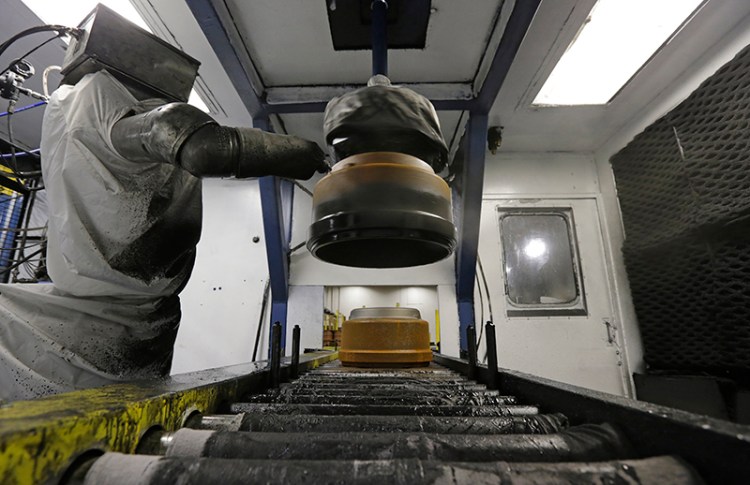WASHINGTON — For the first time since 1999, American employers have added more than 200,000 jobs a month for four straight months, offering more evidence that the U.S. economy is steadily growing while much of Europe and Asia struggle.
Last month’s gain of 217,000 jobs means the economy has finally recovered all the jobs lost to the Great Recession. And it coincides with indications that American consumers have grown more confident. Auto sales have surged. Manufacturers and service companies are expanding.
“I don’t think we have a boom, but we have a good economy growing at about 3 percent,” said John Silvia, chief economist at Wells Fargo. “We’re pulling away from the rest of the world.”
Still, Friday’s report from the Labor Department showed that pay remains subpar for many workers, millions who want full-time work are still stuck in part-time jobs, and the number of people out of work for more than six months remains historically high.
Monthly job growth has averaged 234,000 for the past three months, up sharply from 150,000 in the previous three. The unemployment rate, which is derived from a separate survey, matched April’s 6.3 percent, the lowest in more than five years.
Investors seemed pleased. The Dow Jones industrial average closed up 88 points.
Though the economy has regained the nearly 9 million jobs lost to the recession, more hiring is needed because the working-age U.S. population has grown nearly 7 percent since the recession began. Economists at the liberal Economic Policy Institute estimate that 7 million more jobs would have been needed to keep up with population growth.
In addition, average wages have grown only about 2 percent a year since the recession ended, well below the long-run average annual growth of about 3.5 percent.
And unemployment has fallen from a 10 percent peak in 2009 partly for an unfortunate reason: Fewer people are working or seeking work. The percentage of adults who either have a job or are looking for one remained at a 35-year low in May.
Yet the United States is faring far better than most other major industrial nations.
Overall unemployment for the 18 countries that use the euro was 11.7 percent in April, though some European nations, such as Germany and Denmark, have much lower rates. On Thursday, Europe’s central bank cut interest rates and took other extraordinary steps to try to boost ultra-low inflation, encourage more lending and jump-start growth.
Japan is struggling to emerge from more than a decade of sluggish growth and deflation. And China has been undergoing a prolonged slowdown from explosive expansion and is at risk of slowing too sharply.
“The U.S. was incredibly aggressive” after the financial crisis and Great Recession, said Daniel Drezner, a professor of international politics at Tufts University. “Compared to Europe in particular, we did much more.”
The U.S. government approved stimulus spending and tax cuts, Drezner noted, while many European nations cut spending. The Federal Reserve slashed rates further than the European Central Bank did and launched bond purchases to ease long-term loan rates. Central banks in Japan and Europe have only recently considered the types of unconventional steps the Fed launched in 2008.
The solid U.S. hiring gains in May might be expected to lower the unemployment rate. But the two figures come from separate surveys. The job gains are derived from a survey of businesses, the unemployment rate from a survey of households.
The two surveys sometimes diverge but usually paint a similar picture over time. For May, the survey of businesses found a bigger job gain than the survey of households did.
Average hourly pay rose 5 cents in May to $24.38. That’s up 2.1 percent from 12 months ago and barely ahead of inflation, which was 2 percent.
Weak pay gains have limited Americans’ ability to spend and held back growth, because consumer spending drives about 70 percent of the economy.
“The sluggishness in wages is the weak link that is preventing the U.S. economy from fully expanding its wings,” said Gregory Daco, U.S. economist at Oxford Economics.
One reason pay has lagged: The jobs added since the recession have been more likely to be part time and in lower-paying industries. That pattern was evident in May: Hotels, restaurants and entertainment companies added 39,000 jobs. Retailers gained 12,500, temporary services 14,300.
By contrast, construction firms added just 6,000, manufacturers 10,000. Those industries tend to be higher-paying.
There are still 2.9 million fewer people working in full-time jobs than when the recession began. And nearly 2.5 million more are working in part-time positions. Those trends have eased somewhat in the past year or so, as the number of part-time workers has fallen 500,000 in the last 12 months.
The number of long-term unemployed fell 78,000 to 3.37 million last month, down from 4.4 million a year ago. That’s still nearly three times as many as when the recession began.
The U.S. economy actually shrank in the first three months of this year as a blast of cold weather shut down factories and kept consumers away from shopping malls and car dealerships.
The economy contracted at a 1 percent annual rate, its first decline in three years.
Send questions/comments to the editors.



Success. Please wait for the page to reload. If the page does not reload within 5 seconds, please refresh the page.
Enter your email and password to access comments.
Hi, to comment on stories you must . This profile is in addition to your subscription and website login.
Already have a commenting profile? .
Invalid username/password.
Please check your email to confirm and complete your registration.
Only subscribers are eligible to post comments. Please subscribe or login first for digital access. Here’s why.
Use the form below to reset your password. When you've submitted your account email, we will send an email with a reset code.